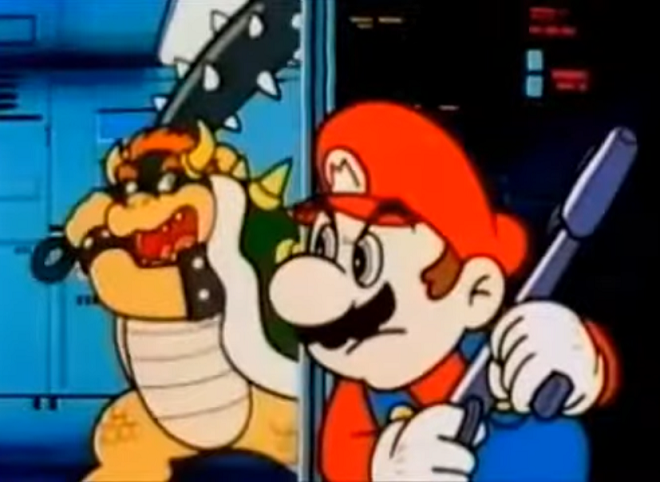A Trip Down the Mario Anime Pipe
The Super Mario Bros. Movie from Illumination Studios hit theaters today, which is garnering a mixed reception from critics based on reviews thus far. Critic opinions are unlikely to harm the initial box office gross, currently projected to earn around $125 over four days in the United States, given the sterling pedigree of the Nintendo franchise. Audience reception to the movie will determine how well it will continue to perform in subsequent weeks, but that may not matter if it makes a good portion of its budget back early. Illumination could get the chance to make a stronger sequel quality-wise.
The Mario movie is only the latest animated work in the franchise. Plenty of prior examples have been popular enough, like the Super Mario Bros. Super Show and the Super Mario Bros. 3 and Super Mario World animated progeny. It has remarkably taken over 30 years for another animated work to be made. But there’s a considerably deeper pipe to venture down that’s not discussed as often: Anime.
There were two anime initiatives in the 1980s, both of which were made to promote the games rather than a serious effort by Nintendo to branch out Mario as a multimedia franchise. The first of which released well before the Super Show.

The anime fun started with Super Mario Bros.: The Great Mission to Rescue Princess Peach!, a movie with a clear creative process. Nintendo told an anime production team to create their own interpretation of the Super Mario Bros. story using the original NES/Famicom game’s story as a base. The result was largely not an interpretation that Nintendo abided by for future works, but turned out, let’s say, interesting regardless. This alone makes it worth looking back on.
It begins with Mario playing a Famicom video game, which eventually plays a scene where Princess Peach is trying to escape familiar Mario franchise enemies. She then jumps out of the screen to tell Mario she’s running from King Koopa (well before he was known as Bowser) and his minions, who are forcing her to marry him on Friday the 13th. Koopa soon follows the Princess out of the TV and kidnaps her, with Mario being no match for him in his base form. Luigi, of course, does not believe any of this upon hearing the explanation, until he sees convincing evidence as the brothers are working in their grocery store (!) in the middle of a desert (!!) the next day. Thus begins their quest, in which they’re both isekai’d into the Mushroom Kingdom.
The original Super Mario Bros. is a bizarre game considering its concepts. This is a game in which a mustached man and his twin brother in overalls fights enemies like walking mushroom-shaped Goombas, turtles that walk and fly whose shells can be kicked, and another turtle in a flying cloud who throws turtles with spiked shells. It’s wild stuff from creative minds, chief among them the venerable Shigeru Miyamoto, which leads to this anime interpretation being similarly creative. The producers found a way to utilize every style of world and every enemy from the games, while taking liberties for the sake of having a viable narrative like including two talking Goombas. Some personalities are also a little different, like the very greedy and miscolored Luigi and a Bows… uh, King Koopa, who’s laser-focused on marrying Peach and little else.
The voicework is similarly fascinating. Toru Furuya voices Mario, which rendered me unable to think about Amuro Ray (from Mobile Suit Gundam — which you hopefully knew) every other time he spoke. More interesting are Peach and Bowser’s voices, neither of whom are played by actors. It, in fact, could not be clearer that Peach wasn’t voiced by an actress (then-teen idoi Mami Yamase), given her inability to emote. Bows… King Koopa’s voice (Akiko Wada — a woman) isn’t bad, but simply different considering future interpretations of the character.
The Mario anime movie isn’t great on its own, which existed as part of Super Mario Bros.: The Lost Levels’ ad campaign. But its interpretations of the game’s themes and the twist ending make it an interesting time capsule. Not to mention the elements of it they did use, especially the way in which Mario defeats Bow… King Koopa (I have legitimately almost typed “Bowser” before correcting myself each time here, including one caught in a proofread) at the end. Kudos to someone getting their Super Mario Bros. fanfic on screen.

The other Mario anime was released as part of the Amada Anime Series, three short OVA episodes based on fairy tales with Mario franchise characters inserted in. They’re not as entertaining as the first Mario anime movie, with animation of so, let’s say, questionable quality that I figured this was a slideshow at the start. But again, they’re interesting considering the interpretations the creators concocted.
One (based off Momotaro) includes Mario fighting back against King Koopa and other franchise enemies with a gun, a sight to behold even if he doesn’t put it to much use, and shows Peach’s grandparents to be turtles of the Hammer Bros. type. The second one (based off Little One-Inch) establishes Mario as a miniature dwarven individual prior to shroom eating, while the last one is based on Snow White with Queen Koopa. They’re largely unremarkable in terms of entertainment value, but they’re nonetheless — and I’m sorry for continuing to use this word — interesting.
Neither of these anime experiments were serious productions, and Nintendo has yet to green light another one. But both serve as intriguing time capsules fortunately preserved (the former movie in a beautifully-restored 4K form) by YouTube uploaders, and Nintendo themselves hasn’t felt it was worth their time to take them down through inane copyright claims. Nintendo’s bound to have their most successful animated initiative yet on their hands now, and they’re unlikely to fund unorthodox franchise experiments like this with even the smallest amount of cash if years-long rumors regarding Miyamoto’s conservative nature are true. That only serves to highlight the remarkable time in which they did exist.





